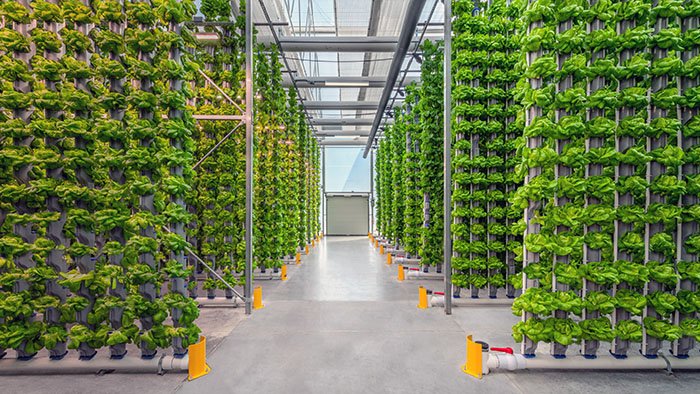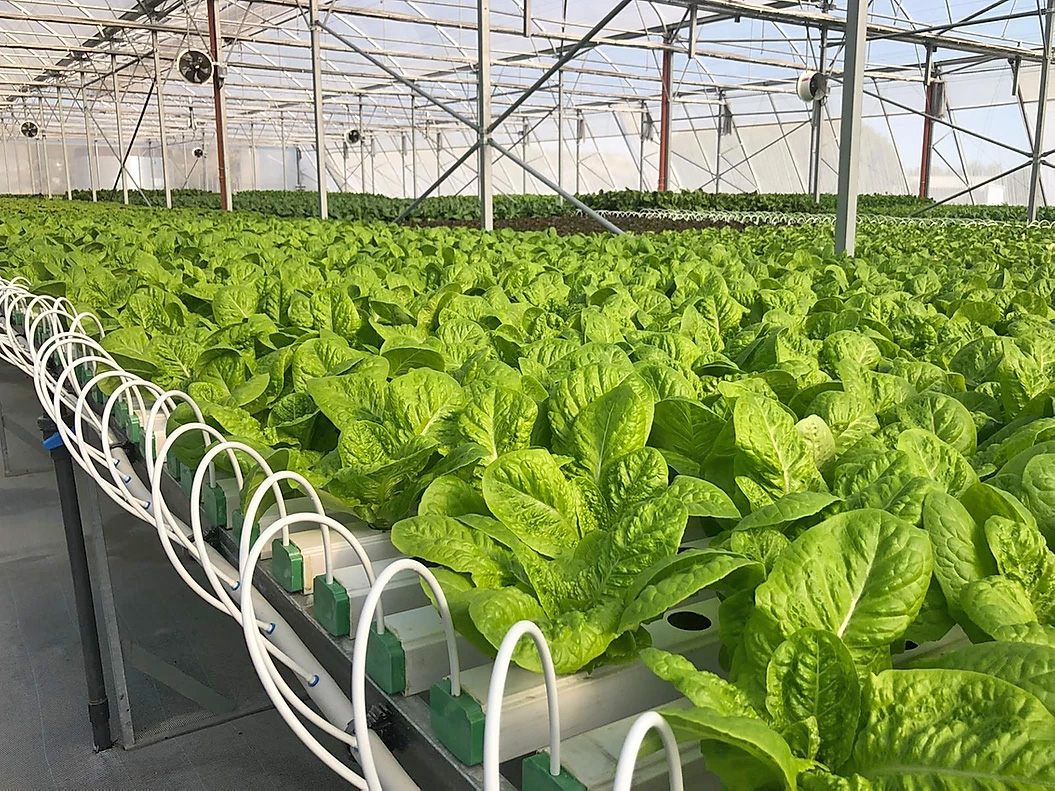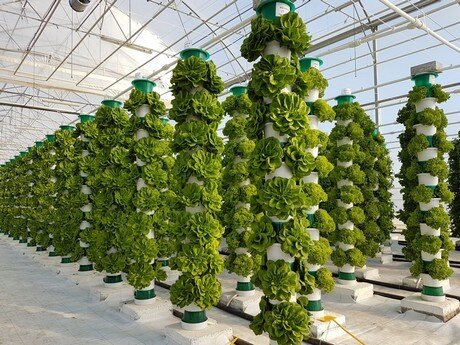Hydroponics vertical farming is transforming how we grow food. It combines soil-less cultivation with space-saving techniques.
Imagine growing plants without soil, using water filled with nutrients. This method is known as hydroponics. Vertical farming stacks plants in layers, maximizing space. Together, they create a powerful solution for modern agriculture challenges. Urban areas face limited space and growing food demands.
Hydroponics vertical farming provides a promising answer. It offers efficient use of resources and reduces waste. Plants grow faster and need less water than traditional methods. This approach is eco-friendly and can be implemented almost anywhere. From rooftops to warehouses, it adapts well. Discover how this innovative method changes the landscape of farming. Learn why more people turn to hydroponics vertical farming for sustainable food production.

Credit: www.edengreen.com
Introduction To Hydroponics
Welcome to the fascinating world of hydroponics! Imagine growing lush, vibrant plants without soil. Sounds like magic, right? Hydroponics is a game-changer in modern agriculture, especially when combined with vertical farming. It’s a method that lets you cultivate plants with a nutrient-rich water solution, maximizing space and efficiency. Whether you’re curious about the science behind it or considering starting your own hydroponic garden, this introduction will give you a solid foundation. Let’s dive into the essentials!
Definition And Basics
Hydroponics is the art of growing plants using water mixed with nutrients instead of traditional soil. This method allows plants to absorb essential nutrients directly from the water, speeding up growth and yield.
The basics are simple: a container, water, and a nutrient solution tailored to your plants’ needs. Add a pump to circulate the solution and you’re ready to start.
The beauty of hydroponics is its adaptability. You can grow herbs, vegetables, and even fruits in small spaces. Think of it as a plant spa, delivering everything your plants need to thrive.
Historical Background
Hydroponics isn’t just a modern invention; it has roots dating back thousands of years. Ancient civilizations like the Babylonians and Aztecs practiced soil-less farming techniques, utilizing water-based systems for cultivation.
In the 1920s, Dr. William Gericke coined the term “hydroponics,” bringing scientific rigor to these age-old practices. His work sparked a revolution, setting the stage for today’s advanced systems.
Consider this: the Hanging Gardens of Babylon might have been an early example of hydroponics. Could ancient ingenuity inspire your next gardening adventure?
Hydroponics offers a practical solution to space constraints, making it ideal for urban environments. As cities grow, so does the need for sustainable food production. Are you ready to join the hydroponics movement and contribute to a greener future?
Vertical Farming Explained
Vertical farming is transforming agriculture. It allows crops to grow in stacked layers. This method uses less land and water than traditional farming. It is ideal for urban areas with limited space. Vertical farming supports sustainable practices and can increase food production.
Concept And Design
Vertical farming involves growing plants in vertically stacked layers. These layers can be shelves, towers, or wall-mounted systems. This design maximizes space, allowing more crops in smaller areas. It also helps control the environment around the plants. Temperature, light, and humidity are easier to manage. This results in healthier crops and higher yields.
Technology And Innovations
Technology plays a key role in vertical farming. LED lights provide artificial sunlight. They are energy-efficient and reduce costs. Sensors monitor plant health and environmental conditions. Automated systems manage watering, nutrients, and climate. This reduces human error and increases efficiency. Innovations continue to improve vertical farming methods. They make it more accessible and effective for farmers worldwide.
Advantages Of Hydroponics
Hydroponics vertical farming offers efficient use of space, allowing plants to grow in stacked layers. It requires less water than traditional farming, reducing environmental impact. Nutrient-rich solutions provide optimal growth conditions, resulting in faster plant production and healthier yields.
Hydroponics is transforming the way we think about agriculture, especially with the rise of vertical farming. This innovative method brings a host of advantages that make it an appealing choice for modern farmers and gardeners alike. Let’s dive into some of the key benefits of hydroponics.Efficient Water Use
Hydroponics uses significantly less water than traditional farming. In fact, it can reduce water usage by up to 90%. This is because water in a hydroponic system is recirculated and reused. Imagine having a garden where you rarely need to worry about water shortages or droughts. That’s the promise of hydroponics. It offers a sustainable solution for areas facing water scarcity. Do you live in a region with frequent droughts? Hydroponics could be your answer to growing fresh produce all year round.Space Optimization
Vertical farming with hydroponics is a game-changer for urban environments. It allows you to grow more in less space, making it perfect for city dwellers with limited room. Think about it: you can have a thriving garden on your balcony or even inside your home. Hydroponic systems can be stacked vertically, maximizing the use of available space. Ever considered turning that empty wall into a lush garden? With hydroponics, it’s entirely possible. You’re not just saving space; you’re creating an urban oasis. By adopting hydroponics, you’re embracing a method that respects both natural resources and modern living constraints. It’s a step towards a more sustainable and productive future.
Credit: www.urbinati.com
Urban Agriculture Benefits
Urban agriculture is changing how we grow and consume food. Hydroponics vertical farming plays a big role in this shift. By growing plants in stacked layers, it uses less space. This method is perfect for cities with limited land. Urban agriculture offers many benefits. It supports sustainability and local economies. Let’s explore how it helps in local food production and reducing the carbon footprint.
Local Food Production
Hydroponics vertical farming boosts local food production. It allows fresh food to grow in urban areas. This reduces dependency on distant farms. Fresh vegetables and herbs are available year-round. It supports local markets and reduces transportation needs. Residents enjoy fresh, healthy produce from nearby sources.
Reduced Carbon Footprint
Growing food locally reduces the carbon footprint. Transporting food long distances burns fossil fuels. Local food production cuts these emissions. Hydroponics uses less water and energy than traditional farming. It also reduces waste and minimizes environmental impact. Urban farms contribute to a cleaner, healthier planet.
Challenges In Implementation
Implementing hydroponics vertical farming can be exciting yet challenging. While it promises efficient use of space and water, it also comes with hurdles that can make or break your farming venture. Understanding these challenges is crucial to ensure you’re prepared to tackle them head-on.
Cost Considerations
The initial investment in hydroponics vertical farming can be steep. From purchasing equipment to setting up infrastructure, costs can quickly escalate. You might need specialized lighting, nutrient solutions, and climate control systems. Have you thought about how these expenses can impact your budget?
Moreover, operational costs can add up. Electricity bills for lighting and climate control are ongoing expenses. Maintenance of equipment and replacement of parts can further strain your finances. Planning a detailed budget can help manage these costs effectively.
Consider exploring financing options or partnerships to alleviate financial burdens. Sometimes, sharing costs with other farmers or seeking grants can ease the pressure.
Technical Barriers
Technical know-how is essential in hydroponics vertical farming. The system requires precise monitoring and adjustments. If you’re unfamiliar with the technology, it can be daunting.
Start with understanding the basics. Learn about nutrient balance, pH levels, and light requirements. Can you imagine the consequences of an imbalance? Crops can fail, leading to significant losses.
Invest in training or hire someone with expertise. There are workshops and online resources that provide valuable insights. The right knowledge can make the difference between thriving crops and a failed system.
Consider the reliability of the technology. Equipment malfunctions or software glitches can disrupt farming operations. Have a backup plan in place and ensure regular maintenance to avoid unexpected disruptions.

Credit: www.edengreen.com
Case Studies And Success Stories
Discover the impact of hydroponics vertical farming through real-life success stories. These case studies highlight innovative techniques and impressive results. Explore how farmers grow fresh produce efficiently, using less space and resources. Learn from their experiences to understand the future of sustainable agriculture.
The world of hydroponics vertical farming is filled with fascinating stories of innovation and success. These stories highlight the potential of this modern farming technique to transform how we grow food. From bustling urban centers to remote corners of the globe, hydroponics vertical farming is making waves. Let’s dive into some inspiring case studies and success stories that showcase the power of this technology.Urban Success Examples
In cities where space is scarce, vertical farming is proving to be a game-changer. Take the example of New York City, where a startup turned an abandoned warehouse into a thriving vertical farm. They now produce fresh greens and herbs, reducing the need for long-distance transportation. Another inspiring story comes from Singapore, a city-state with limited land for traditional farming. A local company developed a vertical farming system on rooftops, supplying fresh produce to nearby markets. This not only saves space but also cuts down on carbon emissions. These urban examples highlight how vertical farming can make cities greener and more self-sufficient. Imagine having a fresh salad grown just a few blocks away from your home!Innovative Projects Worldwide
Vertical farming is not just limited to urban areas; it’s making an impact globally. In Japan, a tech company converted an old semiconductor factory into a vertical farm. Using LED lights and hydroponic systems, they produce lettuce with a fraction of the water needed in traditional farming. In the Middle East, where water is a precious resource, vertical farming is providing solutions. A project in Dubai uses desalinated water to grow crops vertically, overcoming the challenges of arid environments. They provide fresh produce to local supermarkets, showcasing how technology can adapt to unique regional needs. These innovative projects demonstrate that vertical farming can be tailored to different climates and challenges. Could this be the future of sustainable agriculture worldwide? As you explore these stories, consider how hydroponics vertical farming could impact your community. What local challenges could it solve? The possibilities are as vast and varied as the stories themselves.Future Prospects Of Vertical Farming
Vertical farming offers a promising solution for global food challenges. This innovative method grows plants without soil, stacking them vertically. It optimizes space and resources, essential for urban areas. Many see vertical farming as the future of agriculture. Its potential to meet the growing food demand is significant. Let’s explore the future prospects of vertical farming.
Technological Advancements
Technology drives the evolution of vertical farming. Automated systems monitor plant health and growth. Sensors track moisture, light, and nutrient levels. Artificial intelligence aids in optimizing crop yields. Robotics handle planting, watering, and harvesting. These advancements make farming efficient and precise. Energy-efficient LED lights support year-round growth. Reduced energy costs make vertical farming more viable.
Global Impact
Vertical farming can transform food production worldwide. It reduces the need for large agricultural lands. Urban areas can produce fresh food locally. This decreases transport costs and carbon footprints. Vertical farms can operate in diverse climates. They provide food security in regions with harsh weather. This farming method can support sustainable urban development. It offers a solution to feed the growing global population.
Frequently Asked Questions
Do Vertical Farms Use Hydroponics?
Yes, vertical farms often use hydroponics to grow plants without soil. This method efficiently utilizes space and resources. Hydroponics allows precise control of nutrients and water, promoting faster growth. Vertical farming maximizes production in urban areas, reducing transportation emissions and conserving water.
What Are The 5 Disadvantages Of Hydroponics?
Hydroponics can be expensive initially due to equipment costs. It requires constant monitoring and technical expertise. Power outages can harm plant growth. Waterborne diseases spread quickly in hydroponic systems. Nutrient imbalances can occur if not managed properly.
What Cannot Be Grown In Vertical Farming?
Vertical farming struggles with crops needing extensive space, such as corn, wheat, and large root vegetables. These plants require traditional farming methods due to their growth needs. Vertical systems focus on leafy greens, herbs, and small fruits, optimizing space and resources efficiently.
What Is The Biggest Problem With Vertical Farming?
The biggest problem with vertical farming is high energy consumption. It requires artificial lighting and climate control. These systems significantly increase operational costs, impacting profitability. Sustainable energy solutions are essential for reducing expenses and environmental impact.
Conclusion
Hydroponics vertical farming offers a fresh way to grow plants. It saves space and uses less water. Urban areas benefit most from this method. Plants grow faster and produce more. This technique helps feed more people with fewer resources. Many farmers are turning to hydroponics for better yields.
This farming style is eco-friendly and sustainable. It reduces the need for pesticides. Growing food indoors is now possible and efficient. Hydroponics may be the future of farming. Start small and see the benefits for yourself. Explore this innovative method today.





